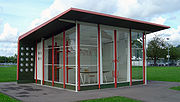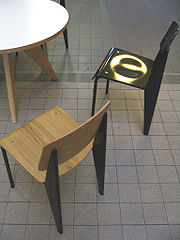
Jean Prouvé
Encyclopedia


Architect
An architect is a person trained in the planning, design and oversight of the construction of buildings. To practice architecture means to offer or render services in connection with the design and construction of a building, or group of buildings and the space within the site surrounding the...
and designer
Designer
A designer is a person who designs. More formally, a designer is an agent that "specifies the structural properties of a design object". In practice, anyone who creates tangible or intangible objects, such as consumer products, processes, laws, games and graphics, is referred to as a...
. His main achievement was transferring manufacturing technology from industry to architecture, without losing aesthetic qualities. His design skills were not limited to one discipline. During his career Jean Prouvé was involved in architectural design
Architectural Design
Architectural Design, also known as AD, is a UK-based architectural journal first launched in 1930.In its early days it was more concerned with the British scene, but gradually became more international. It also moved away from presenting mostly news towards theme-based issues...
, industrial design
Industrial design
Industrial design is the use of a combination of applied art and applied science to improve the aesthetics, ergonomics, and usability of a product, but it may also be used to improve the product's marketability and production...
, structural design and furniture design.
Early years
Jean was born in Nancy. He grew up surrounded by the ideals and energy of his father Victor Prouvé's art collective, "l'École de Nancy". This school came together with the intent of making art readily accessible, to forge a relationship between art and industry, and to articulate a link between art and social consciousness. llMiddle years
Prouvé was first apprenticed to a blacksmith, Émile Robert, and then to the metal workshop of Szabo. In Nancy in 1923 he opened what would be the first in a string of his own workshops and studios. He produced wrought iron lamps, chandeliers, hand rails and began designing furniture. In 1930 he helped establish the Union of Modern Artists whose manifesto read, "We like logic, balance and purity."Although Jean Prouvé shaped his public image around the idea that he was not married to a specific aesthetic, the tenets of "l'École de Nancy" were certainly a powerful influence on his body of work. "I was raised," Prouvé says, "in a world of artists and scholars, a world which nourished my mind."
He opened the successful "Ateliers Jean Prouvé" in 1931 and began collaborating with French architects Eugène Beaudoin and Marcel Lods on projects such as the Maison du Peuple in Clichy
Clichy, Hauts-de-Seine
-Administration:The canton covers a part of the commune; the other is in the northern part of Levallois-Perret-Twinnings: Heidenheim, Germany, since 1959 Sankt Pölten, Austria, since 1968 Santo Tirso, Portugal, since 1991 Rubí, Spain, since 2005 Southwark, United Kingdom, since 2005Clichy has also...
, an aviation club and an army camp. He also collaborated with Charlotte Perriand
Charlotte Perriand
Charlotte Perriand , was a French architect and designer. Her work aimed to create functional living spaces in the belief that better design helps in creating a better society...
and Pierre Jeanneret
Pierre Jeanneret
Pierre Jeanneret was a Swiss architect who collaborated with his more famous brother Charles Edouard Jeanneret for about twenty years....
on a variety of furniture designs. The war kept "Ateliers" in business manufacturing bicycles and a stove called "Pyrobal" that could burn on any fuel. During the war Prouvé was also politically active as a member of the Resistance and he was recognized for this involvement after the war by being named mayor of Nancy. He was also made a member of the Advisory Assembly after Liberation and made the Departmental Inspector for Technical Education. "Ateliers Jean Prouvé" were commissioned by the Reconstruction Ministry to mass-produce frame houses for refugees.
In 1947 he built the Maxéville factory where he produced furniture and undertook extensive architectural research on the uses of aluminum. They built industrial buildings from aluminum and sent hundreds of aluminum sheds to Africa
Africa
Africa is the world's second largest and second most populous continent, after Asia. At about 30.2 million km² including adjacent islands, it covers 6% of the Earth's total surface area and 20.4% of the total land area...
. He also designed an aluminum prefabricated house, the Maison Tropicale, for use in Africa, though only 3 were built. After Maxéville he started "Constructions Jean Prouvé" whose major works were a cafe in Evian
Evian
Evian is a French brand of mineral water coming from several sources near Évian-les-Bains, on the south shore of Lake Geneva.Today, Evian is owned by Danone Group, a French multinational company...
, a pavilion for the centennial of aluminum and the Abbey Pierre house.
In 1953, Prouvé designed the facade of the restaurant of the Hotel de France in Conakry
Conakry
Conakry is the capital and largest city of Guinea. Conakry is a port city on the Atlantic Ocean and serves as the economic, financial and cultural centre of Guinea with a 2009 population of 1,548,500...
, Guinea
Guinea
Guinea , officially the Republic of Guinea , is a country in West Africa. Formerly known as French Guinea , it is today sometimes called Guinea-Conakry to distinguish it from its neighbour Guinea-Bissau. Guinea is divided into eight administrative regions and subdivided into thirty-three prefectures...
, consisting of shutters that pivoted and opened on the sea.
In 1957 he started the Industrial Transport Equipment Company and built the Rotterdam Medical School, the Exhibition Center in Grenoble
Grenoble
Grenoble is a city in southeastern France, at the foot of the French Alps where the river Drac joins the Isère. Located in the Rhône-Alpes region, Grenoble is the capital of the department of Isère...
and the Orly
Orly
Orly is a commune in the southern suburbs of Paris, France. It is located from the center of Paris.The name of Orly came from Latin Aureliacum, "the villa of Aurelius"....
Airways Terminal façade.
In 1958 he collaborated on the design of La maison du Sahara, a modern prototype of a house built for extreme climate conditions. Between 1952 and 1962 he collaborated with Jean Dimitrijevic on the Musée des Beaux Arts du Havre, a glass, steel and aluminum structure that received the prix Reynolds in 1962.
Late years
In 1971, Jean Prouvé was the president of the Jury for the design of the Centre Pompidou in Paris. He played a very important role for the choice of the winning project by Richard RogersRichard Rogers
Richard George Rogers, Baron Rogers of Riverside CH Kt FRIBA FCSD is a British architect noted for his modernist and functionalist designs....
and Renzo Piano
Renzo Piano
Renzo Piano is an Italian architect. He is the recipient of the Pritzker Architecture Prize, AIA Gold Medal, Kyoto Prize and the Sonning Prize...
.
The metal furniture of Jean Prouvé was produced copiously in every studio and workshop. The style is set apart from the Bauhaus
Bauhaus
', commonly known simply as Bauhaus, was a school in Germany that combined crafts and the fine arts, and was famous for the approach to design that it publicized and taught. It operated from 1919 to 1933. At that time the German term stood for "School of Building".The Bauhaus school was founded by...
steel furniture of the time by his rejection of the steel tube technique. Prouvé had more faith in the durability and form of sheet metal, "bent, pressed, compressed than welded". His designs speak of a work philosophy that includes knowledge of the materials at hand, a commitment to collaboration between artists and craftsmen, an attention to evolving technical developments, and "the principle of never postponing decisions so as neither to lose the impetus nor indulge in unrealistic forecasts". Prouvé was influential in the development of the idea of nomadic architecture, likening a chair to a house, and designing both with portability in mind.
He died in Nancy in 1984.
Images
- Maison de la Tunisie Bench-Bookshelf 1952
- photo of Jean Prouvé and biography (français) from the archives of the Centre Pompidou

